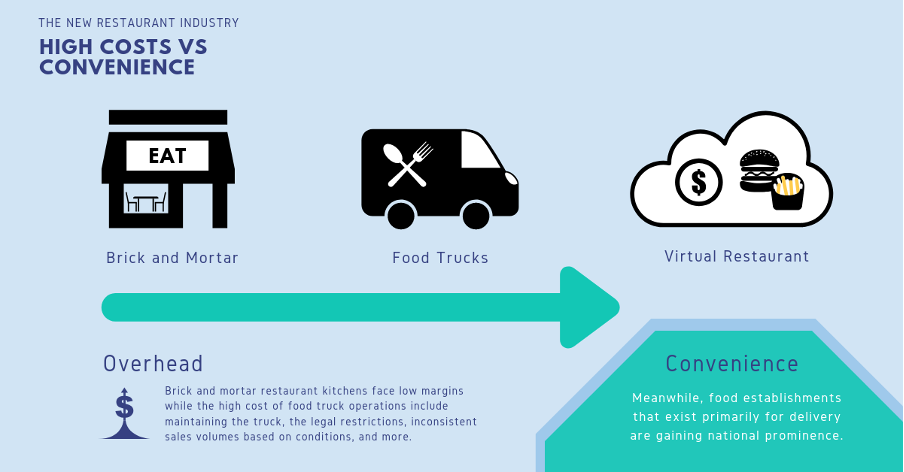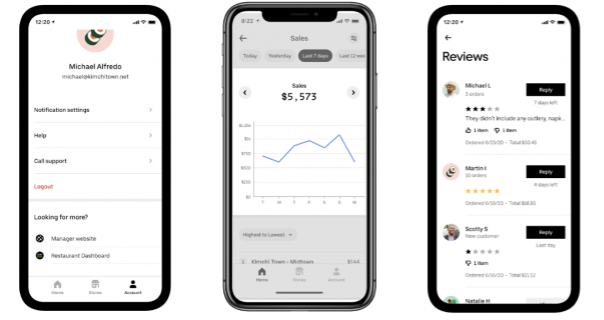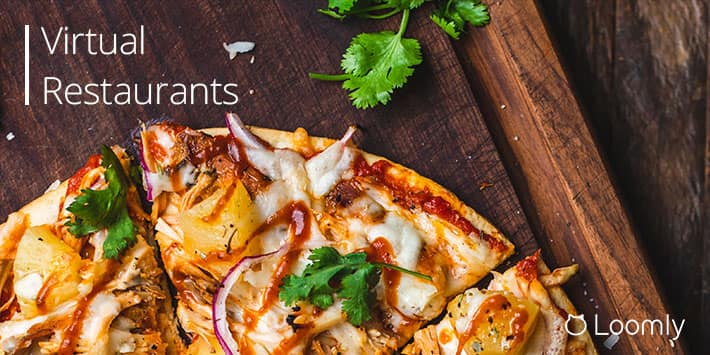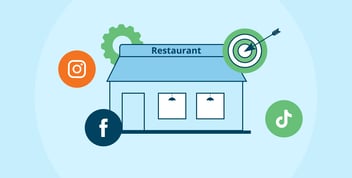Virtual Restaurants: Why Your Brand Should Care (Even If You Are Not In The Hospitality Industry)
Virtual restaurants are not only a new business model changing the way traditional restaurants operate – or a lifeline for the hospitality industry during the pandemic – they also represent a new branding and revenue stream opportunity for creators and brands.
In this guide, we’ll explore the concept behind virtual restaurants and how your brand can emulate the model even if you’re not in the hospitality sector.

Manage all your social media accounts in one place.
Craft, schedule, & auto-post content to all your social channels, then track analytics and manage interactions from a single, easy-to-use dashboard.
What are Virtual Restaurants?
Virtual restaurants, also called ghost restaurants or ghost kitchens, offer a delivery-only dining experience. Customers order food via digital apps, and their food is usually delivered by a third-party service.
A virtual restaurant can be located in various types of buildings, such as:
- A physical restaurant.
- For example, Top Round Roast Beef in San Francisco, produces food for several virtual restaurants: Red Ribbon Fried Chicken, TR Burgers and Wings, and Ice Cream Custard.
- A kitchen space that’s purely a production kitchen, typically a converted warehouse or non-descript building, which could be shared with other virtual restaurants.
- These may also be known as Pop-Up Virtual Restaurants, Pop-Up Kitchens, Ghost Kitchens, Cloud Kitchens, Shared Kitchens, or Dark Kitchens.
- A food truck.
Virtual restaurants are becoming more popular due to mobile technology advancements and the increased efficiencies of at-home delivery services, such as Doordash, Uber Eats, Grubhub, and Deliveroo.
UBS forecasts food delivery sales will grow annually by almost 20% – from $35 billion to $365 billion worldwide by 2030.
Like traditional restaurants, virtual restaurants only prepare customers’ food once they order it, which means many establishments can offer customization options for their menu items.
Virtual restaurants don’t have the expenses and overhead of traditional brick-and-mortar restaurants and provide customers with a more convenient and faster way to dine.

Credit: The Food Corridor
Why Virtual Restaurants Matter Today, Beyond the Hospitality Industry?
It’s not only the hospitality industry that should be fascinated with the concept of virtual restaurants.
In the same way that virtual restaurants have taken off, there’s an opportunity for brands in other sectors to create new experiences for their audiences and build customer loyalty beyond selling their traditional products.
COVID-19 has accelerated the rise of ghost kitchens/ virtual restaurants:
- Online delivery has grown 3x faster than dine-in traffic since 2014.
- The number of ghost kitchens is growing worldwide:
- US = 1500
- UK = 750
- China = 7500
- India = 3500
- Third-party managed cloud kitchen platforms like Kitopi, Cloud Kitchens, and Kitchen United make it easier for restaurants to test the concept of ghost kitchens.
A couple of years back, famous DJ Steve Aoki started a small-scale delivery-only pizza chain named Pizzaoki. Currently, his virtual restaurant operates out of LA’s Cloud Kitchens, which provides cooking space for multiple LA restaurants. But that will have to change in the future as Aoki plans to expand across America and possibly into Europe.
Who’d have imagined a DJ extending their brand to market a virtual restaurant? But if a celebrity can do it, surely other brands can move beyond their traditional offering.
Not convinced yet? Read the story of MrBeast Burger:
The example of MrBeast burger chain (300+ locations launched overnight)
Successful YouTuber MrBeast tapped into his 52+ million subscribers to open his own burger chain across America.
Background:
With estimated earnings of USD 24 million, MrBeast is the second-highest paid YouTuber in the world.
His videos are a mix of humor and expensive stunts, often with a charitable angle. For example, a typical video features him giving away thousands of dollars to various people or groups. (The money usually comes from large companies and sponsors promoting their brand to a young audience.)
MrBeast Burger:
In true MrBeast style, he launched his new restaurant chain by giving people money to try his burger for free. During the launch, there were other prizes, including iPads and a car. Plus, some of the profits were donated to charities too.
I just launched 300 restaurants nationwide! Just go on your favorite delivery app and order a MrBeast Burger! WE’VE BEEN WORKING ON THIS FOR FOREVER AND IM SO EXCITED! pic.twitter.com/hn7tXeWrOu
— MrBeast (@MrBeast) December 19, 2020
However, he didn’t open 300 physical restaurants overnight. Instead, he created a delivery-only brand where customers either order via the MrBeast Burger app or other third-party delivery apps such as UberEats, Doordash, Grubhub, and Postmates.
At the launch, the food was prepared in the kitchen locations of Brio Italian Grille and Buca di Beppo. But other restaurant owners also have the opportunity to add the virtual MrBeast Burger concept to their existing kitchen to generate another revenue stream.
How to Launch Your Own Virtual Restaurant
If you’d like to launch your own virtual restaurant, follow the six steps detailed below.
Step 1: Create your business plan
The first step for any new business is to create a business plan, and it’s no different for your virtual restaurant. A detailed business plan will help you clarify your goals and objectives, plus it will help when you’re seeking investment.
There are three key areas to pay attention to when creating your business plan.
Market research
Start with the research you’ve completed on competitors and other virtual restaurants in your market, including growth stats, demand, pricing trends, and current challenges. The aim here is to demonstrate how you differ from your competition and how you can grow your business in the next few years.
Products and services
Next, you’ll want to highlight the type of food you’re going to sell on your menu, where you’re going to source ingredients from, how long items will take to cook, and the third-party services you’re going to use for delivery.
Financial projections
As a new business, you can only make financial projections based on your research. You can include projected monthly income, cash flow forecasts, and funding details.
You’ll need to secure funding to cover your startup costs, such as cooking supplies, renting kitchen space, developing a website and online delivery app, hiring employees, and marketing your business. Consider using:
- Term loans: Check the various products available for standard business term loans for restaurants.
- Business lines of credit: Lines of credit let you borrow the amount of capital you need when you need it (rather than taking out a lump sum), so you only pay interest on the amount you borrow.
- Small business grants: Check if small business grants are available in your area.
Step 2. Identify your market
In this step, you’ll want to identify your target market and how you’re going to reach those customers. For example, you might know you’re going to sell pizzas, but who are you targeting? For example, is it college students, young professionals, families, mobility-limited seniors, or special diet requirements?
Based on that information, you’ll need to work out your pricing strategy. For example, if you’re targeting college students, you’ll need a lower price point than targeting young professionals.
Finally, you’ll need to decide on your operating hours. For instance, will you be closing at 11pm or staying open till the early hours?
Step 3. Establish your branding and marketing
Your virtual restaurant is an online venture, so you’ll need to develop your brand’s logo, establish brand colors and fonts, decide on any slogans or catchphrases, build a website and an app, plus set up your social media profiles.
Branding and marketing a new business and attracting customers will take time. You’ll need to connect with potential customers in creative ways. For example:
Offline:
- Print and distribute flyers in local neighborhoods.
- Sponsor local events.
Online:
- Post consistently and creatively on social media to build a following.
- Build rapport and build an audience.
- Respond to your community and customers.
- Ask for reviews of your food.
Step 4. Choose a commercial kitchen
It’s a legal requirement to produce your food in a licensed commercial kitchen if you want to sell it to consumers.
One option is to rent space in a shared kitchen, just like an office worker might rent a desk in a coworking space. You can search for commercial kitchen space by city or zip code on The Kitchen Door.
You’ll also need to get the necessary licenses and permits in place:
Business registration: Contact your city or county office to apply for a business license and pay licensing fees.
Food handler’s license: Typically, any restaurant owner and employees are required to obtain a license, like the ServSafe Food Handler Certification, to demonstrate they understand general and food-handling laws.
Catering license: Some states require catering licenses for any restaurant that delivers food. (Note: this may not apply if you utilize third-party delivery services.)
Kitchen inspection certification: If you have a private kitchen, you’ll need to ensure your food preparation and cooking areas are inspected and comply with state laws. Shared kitchen spaces must also meet inspection codes but will most likely be handled by the overall kitchen building owner.
Liability insurance: Most shared kitchen operators will require you to have a $1 million general liability policy that designates your kitchen space as co-insured.
Always check with your local government health inspector to ensure you have all the necessary paperwork completed.
Step 5. Select your service provider(s)
One of the most important steps in running your virtual restaurant is to decide on your service providers. There are two sides to this – who is going to supply you and who is going to supply your customers.
Suppliers
Research and select suppliers for all the parts of your production process, from the food ingredients to the kitchen utensils, cleaning supplies, food containers, and food delivery bags.
Delivery services
Research the costs and decide if you’ll use a local or national delivery service or set up your own service. The basic process for most third-party food delivery services is:
- Customers find your app menu and place their orders.
- You fulfill the orders and hand them off to a delivery partner.
- The delivery partner delivers the orders to the customers.
Most third-party delivery companies, such as DoorDash, Caviar, Postmates, Grubhub, and UberEats, charge up to 30% in commission fees to deliver your food orders. On the plus side, you don’t have to worry about deliveries or payments as everything, including your menu, sales, and reviews, is hosted in your delivery partner’s app.

Credit: Uber
If you decide to handle delivery yourself, you’ll have to develop your own delivery app and website that handles online orders and deliveries for your virtual restaurant. Plus, you’ll need to hire delivery staff and possibly lease vehicles.
Step 6. Launch and improve
With all those steps in place, you’re nearly ready to launch.
But first, you’ll need to have a trial phase where you can get used to the whole process of receiving, cooking, and delivering orders, followed by a beta test for a small area. When you’ve got everything off to a tee, you can officially open for business.
Once your virtual restaurant is operating, you need to evaluate the whole process and see where you need to adjust as part of your continuous improvement. Make sure you listen to customer feedback as part of your evaluation.
Virtual Restaurants in a Nutshell
Launching a virtual restaurant is a more cost-efficient and profitable way to operate in the hospitality sector.
Virtual restaurants and ghost kitchens don’t have the expenses and overhead of traditional brick-and-mortar restaurants and provide customers with a more convenient and faster way to dine.
Although food delivery sales are forecast to grow by 20% over the next ten years, it’s not the only sector and virtual business to consider. Your brand can pivot beyond selling your traditional products by creating a new experience for your existing audience.



